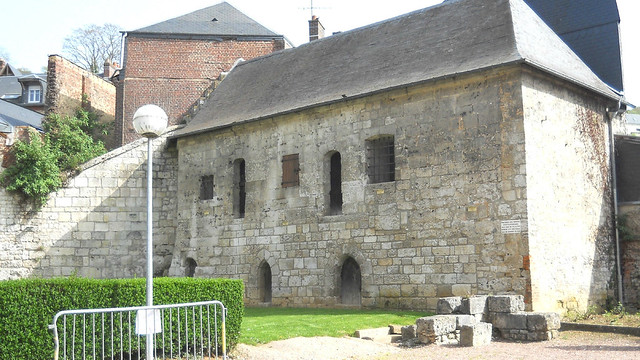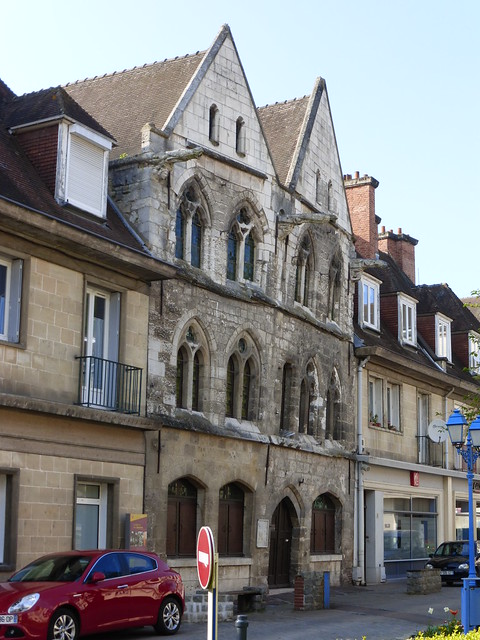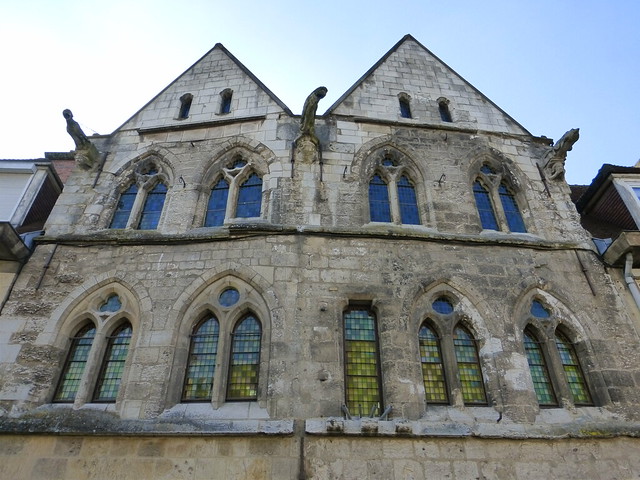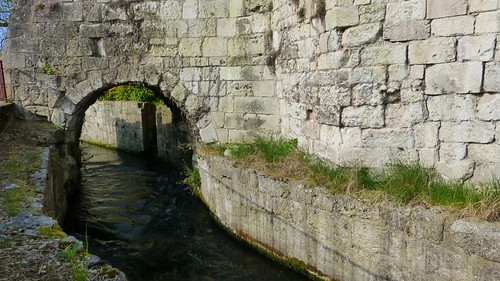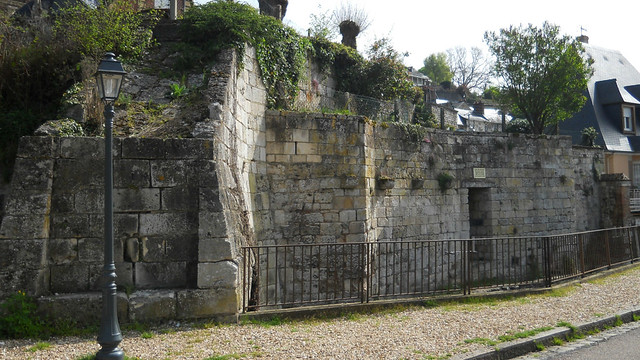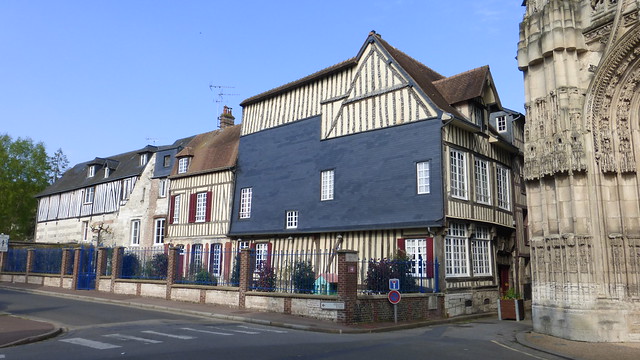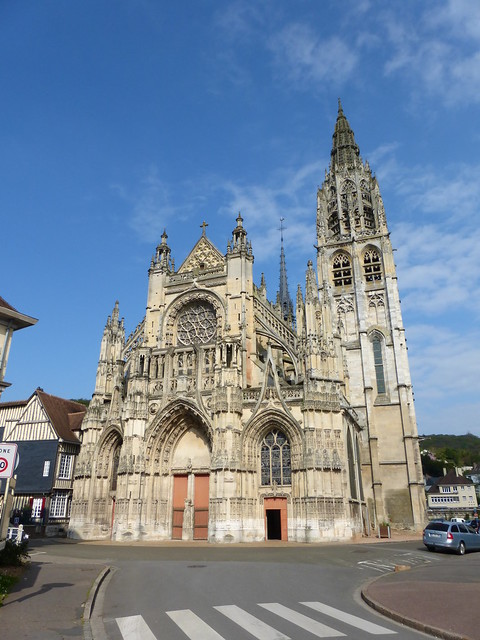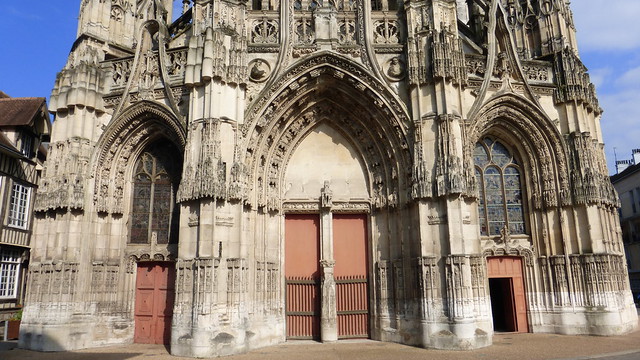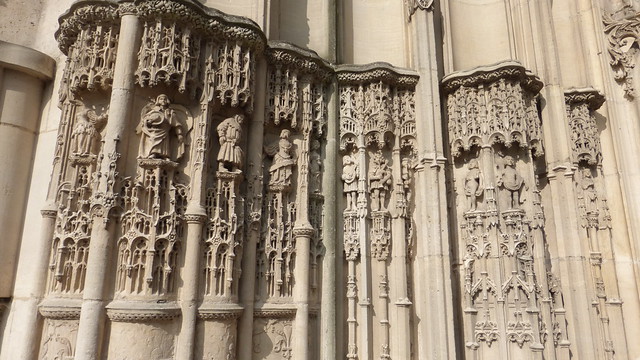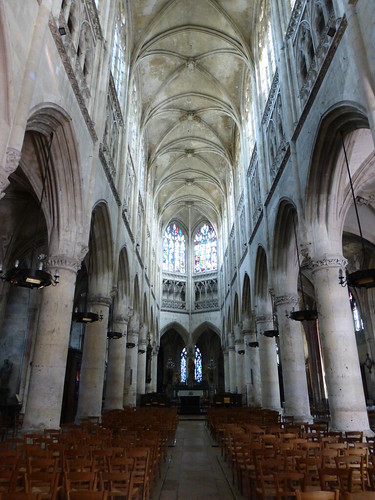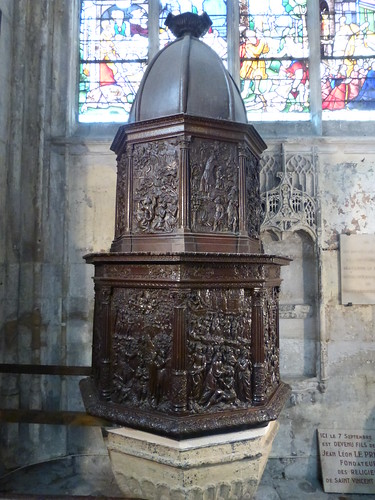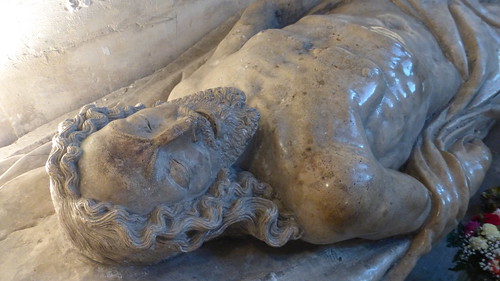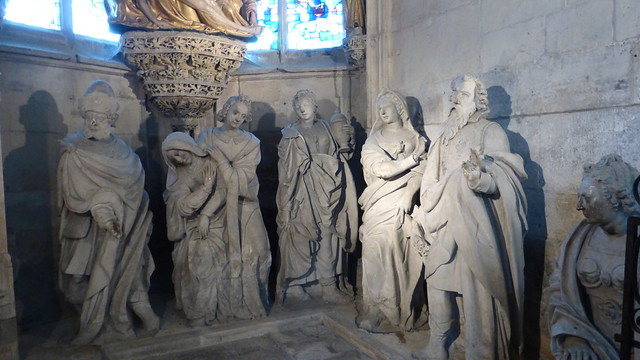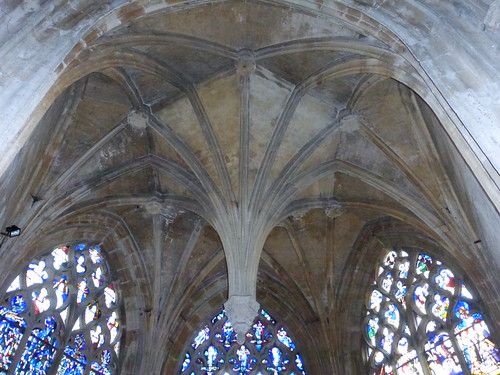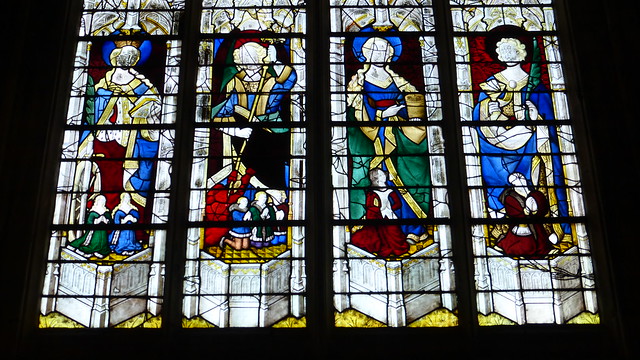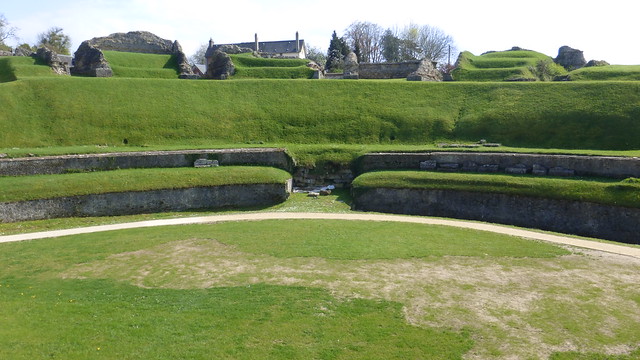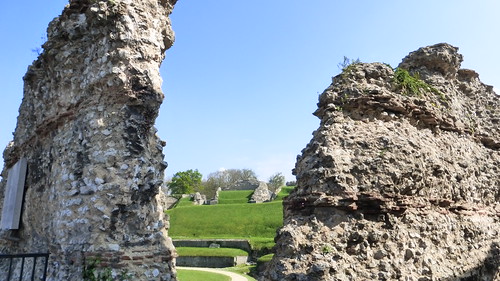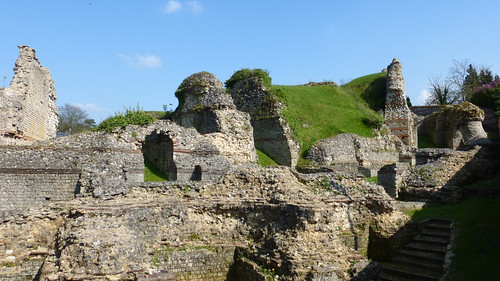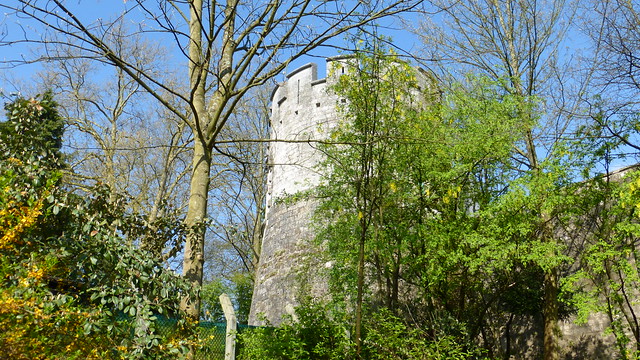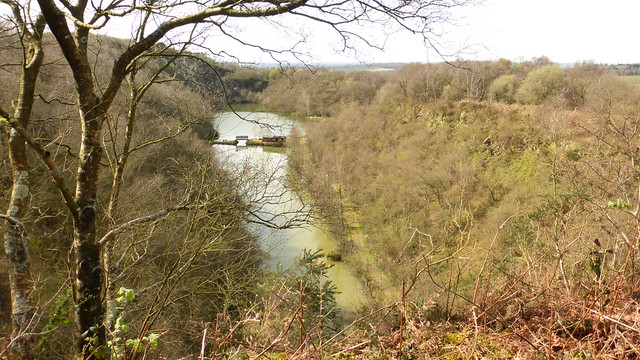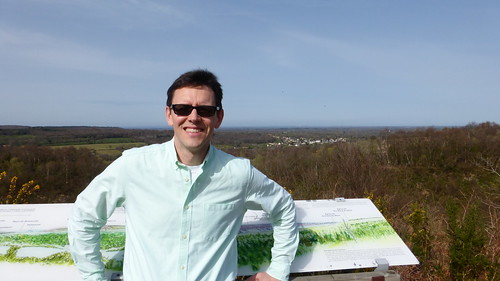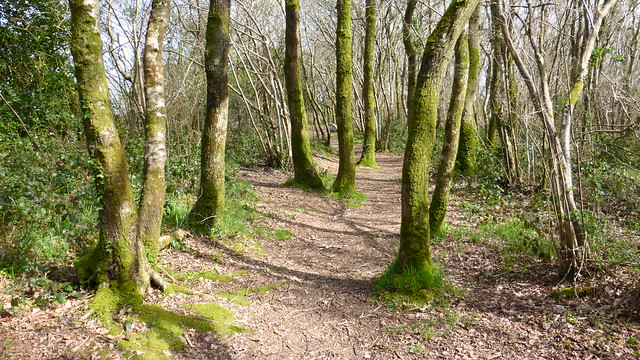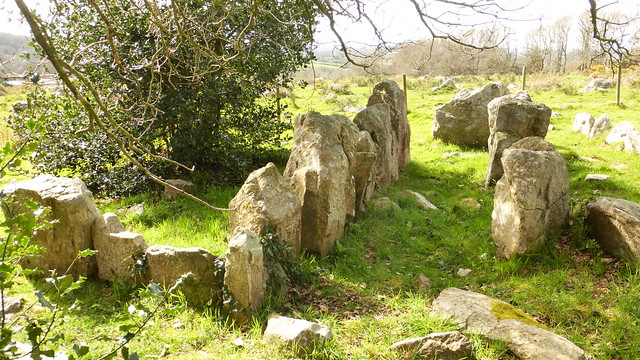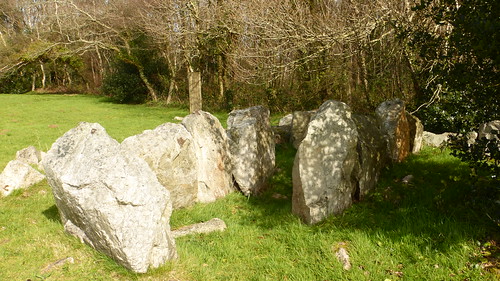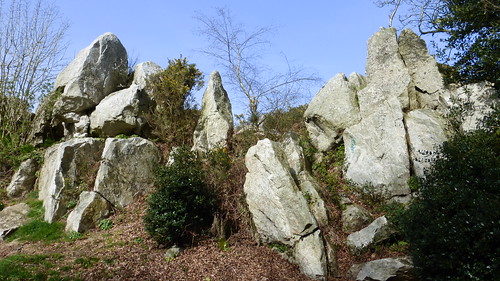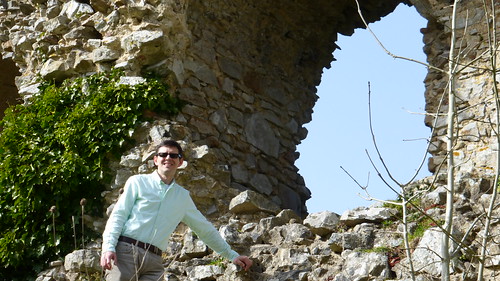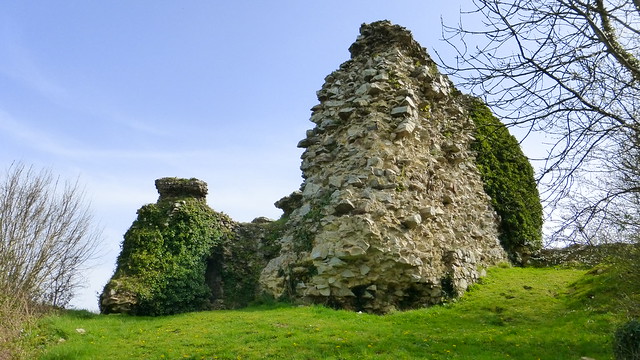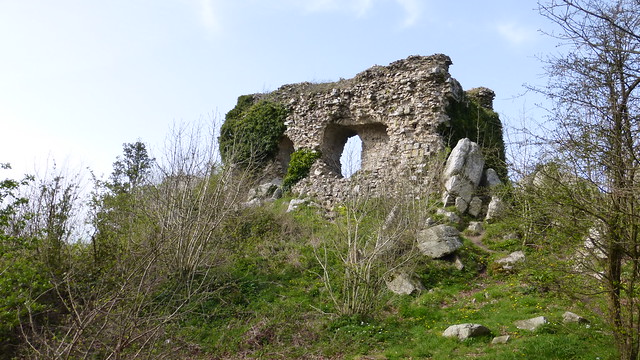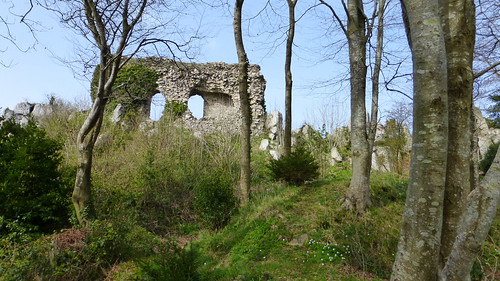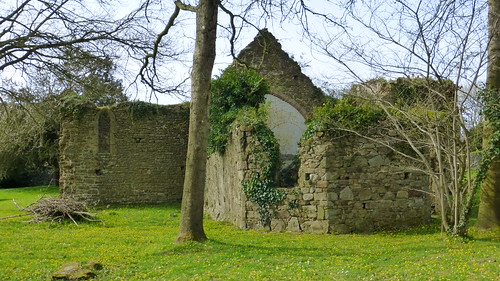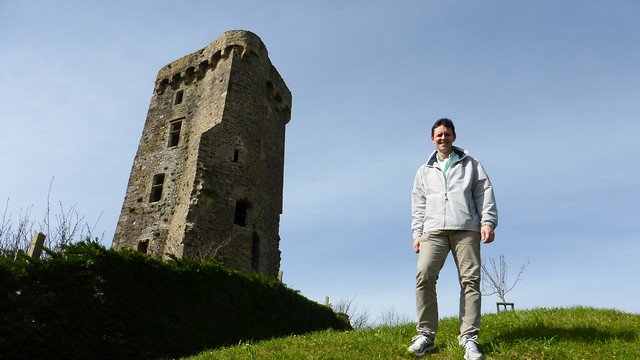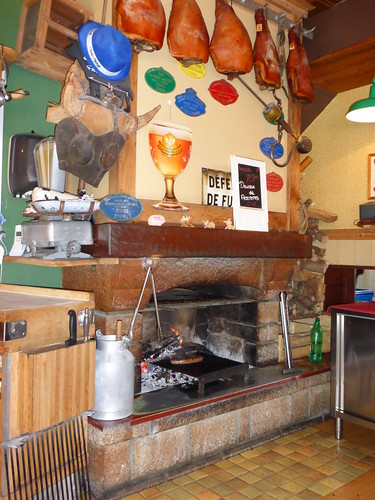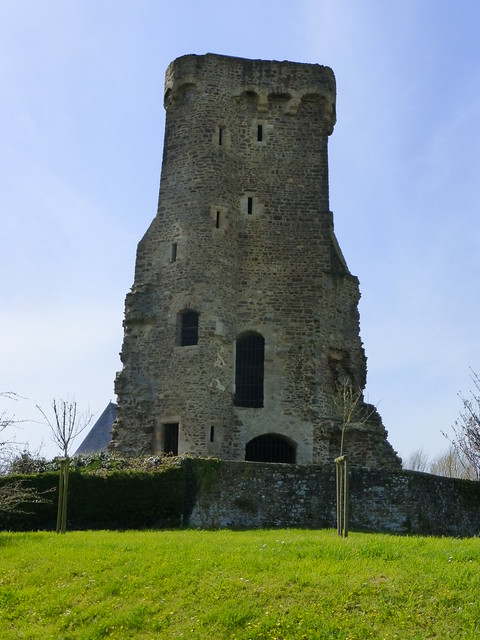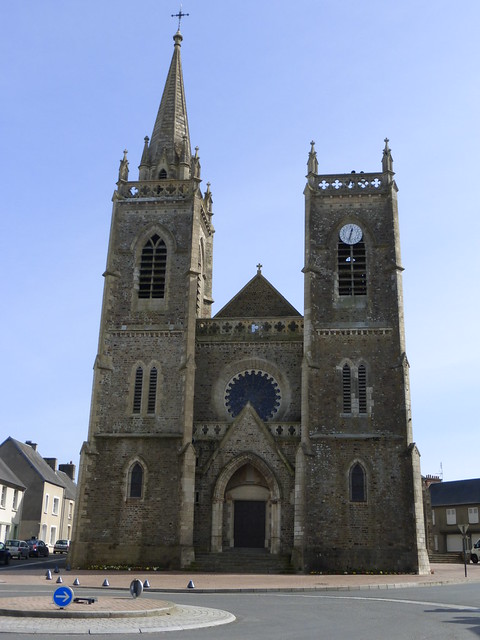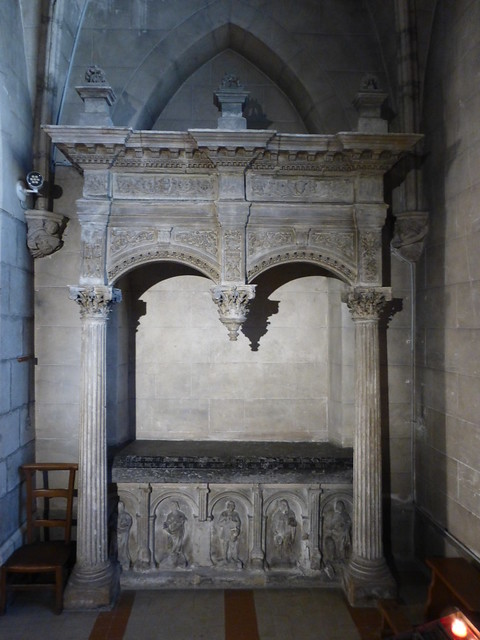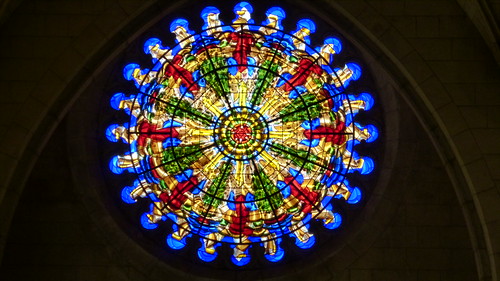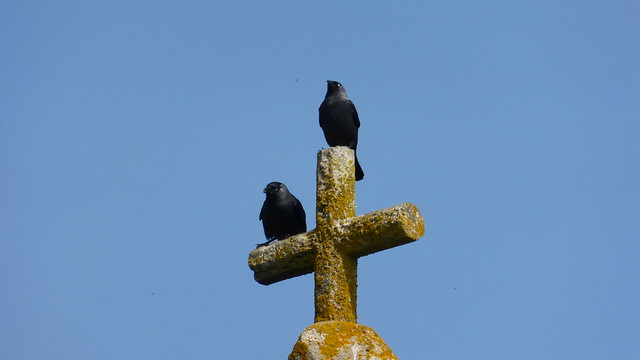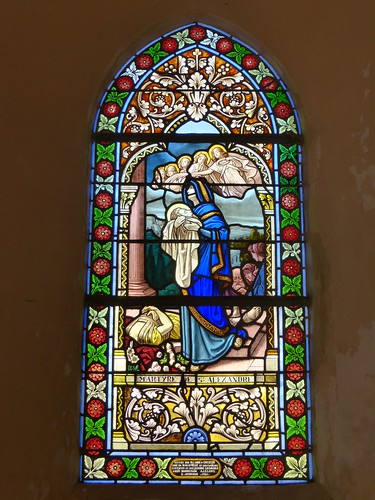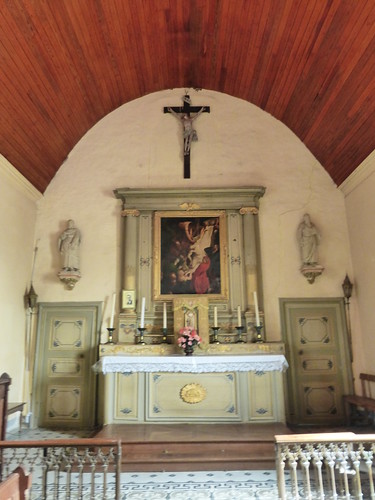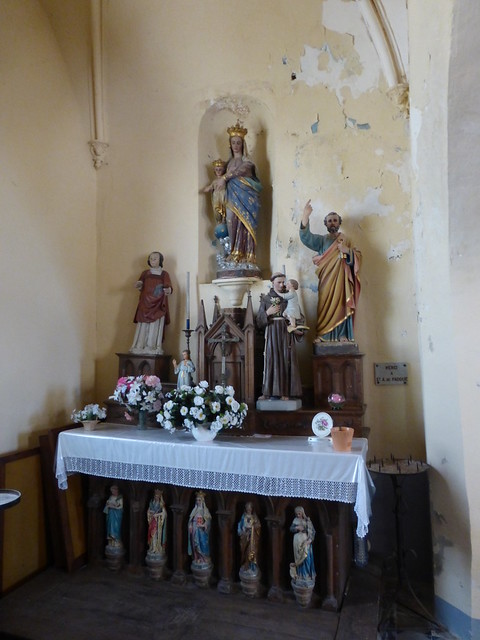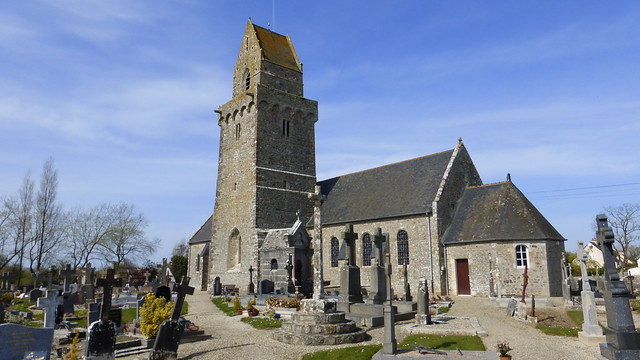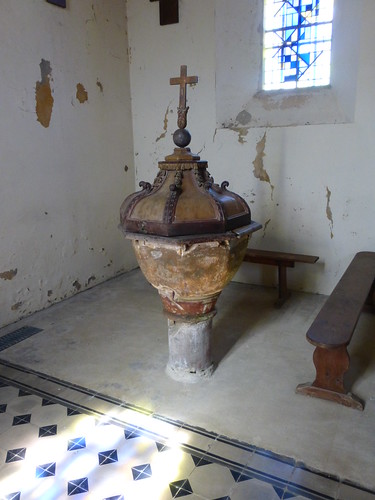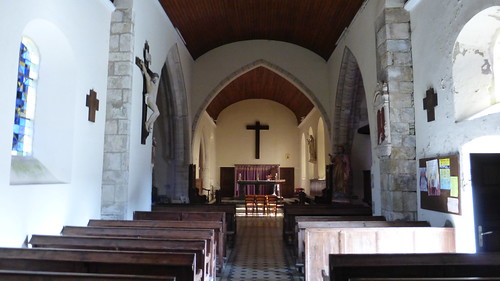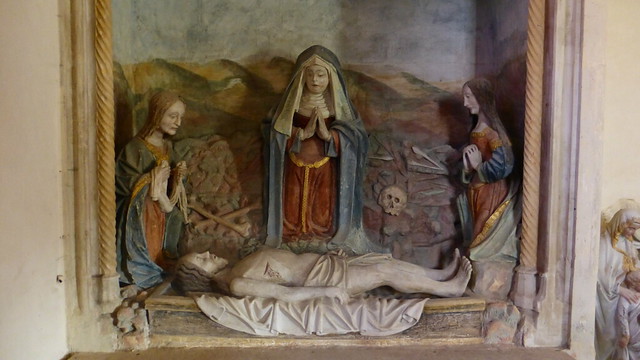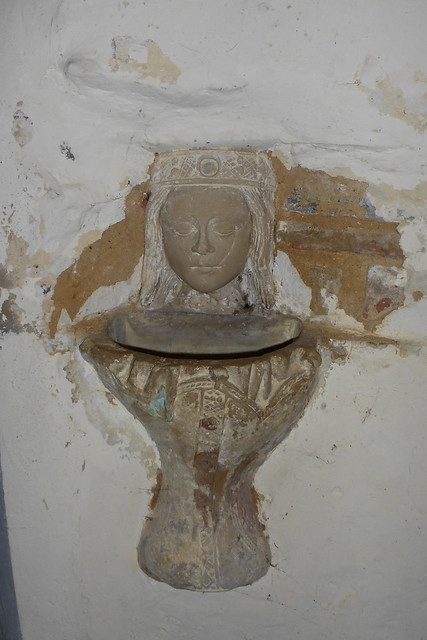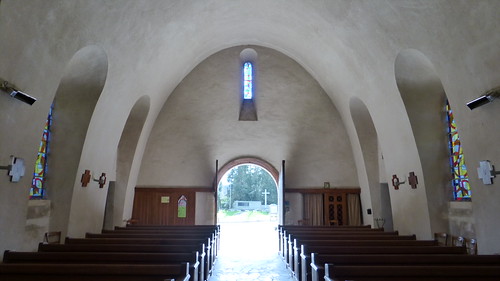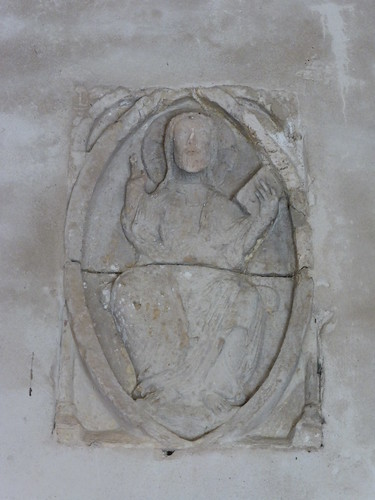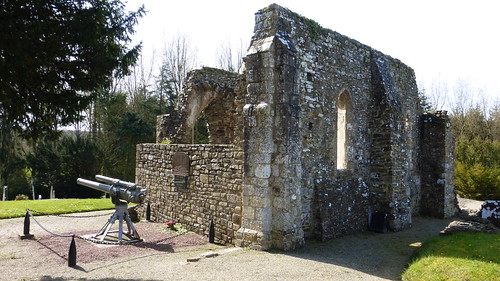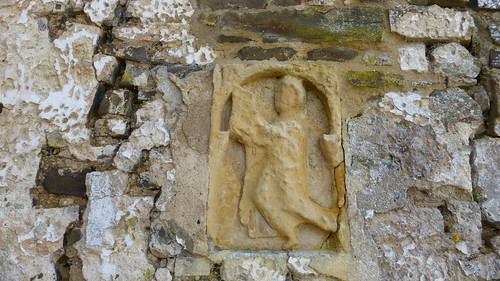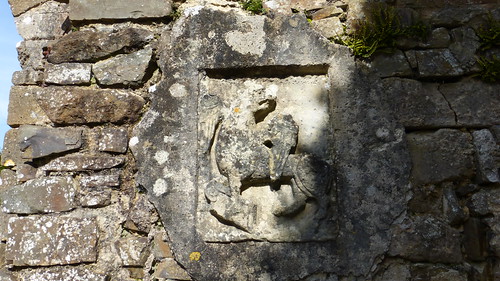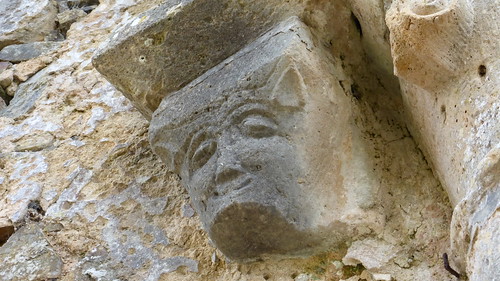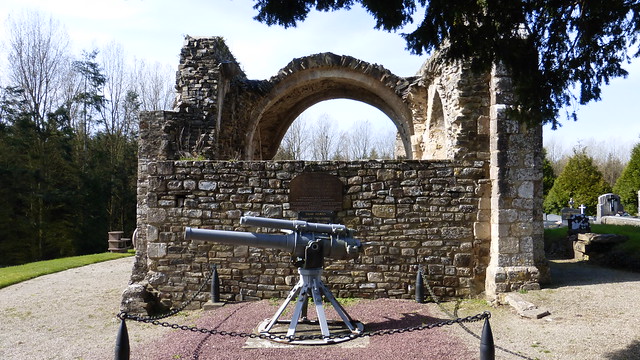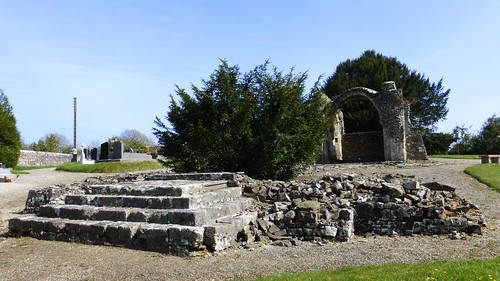April 17 2014
4
17
/04
/April
/2014
10:26
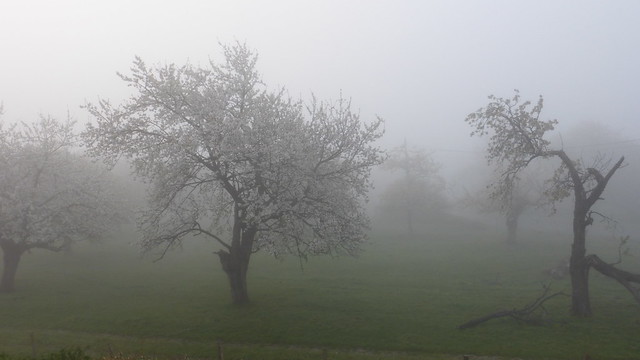
If I didn’t already tell you, let me say it again: the weather in Haute Normandie was just wonderful last weekend. Not only were the fruit trees blossoming, so were the cherry trees and fields of yellow rape.  On the morning of my second day, I had a sumptuous breakfast in the dining room of our chambre d’hote. The owner was very kind and served us fresh crepes with several different homemade jams and conserves. While I ate, I wondered what the day was going to bring since the countryside appeared to be covered in a thick fog.
On the morning of my second day, I had a sumptuous breakfast in the dining room of our chambre d’hote. The owner was very kind and served us fresh crepes with several different homemade jams and conserves. While I ate, I wondered what the day was going to bring since the countryside appeared to be covered in a thick fog. 
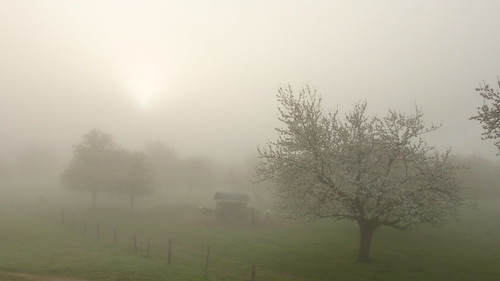
 I took a few photos of Au Temps de Cerises and then decided that the fog would likely burn off by the time I reached my first destination for the day, the Château de Robert le Diable.
I took a few photos of Au Temps de Cerises and then decided that the fog would likely burn off by the time I reached my first destination for the day, the Château de Robert le Diable. 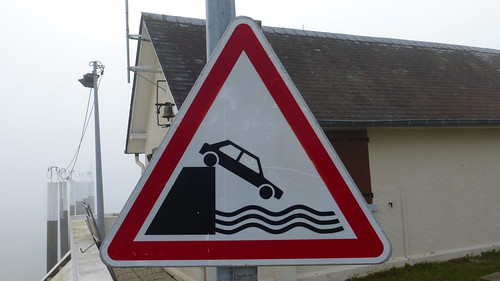 Since there was no bridge over the Seine nearby, we would have had to take the road around the river and put over 50km on our car. Fortunately, drivers can take the ferry over the river at Le Mesnil-sous-Jumièges and the distance is only 18km.
Since there was no bridge over the Seine nearby, we would have had to take the road around the river and put over 50km on our car. Fortunately, drivers can take the ferry over the river at Le Mesnil-sous-Jumièges and the distance is only 18km. 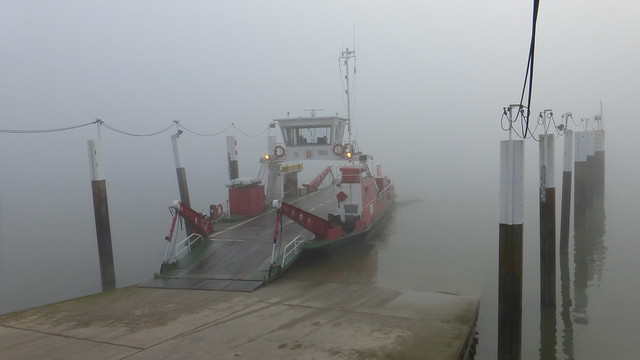 The ferry had to wait for eight vehicles to board before casting off to the other side of the Seine which we couldn’t even see because of all the fog.
The ferry had to wait for eight vehicles to board before casting off to the other side of the Seine which we couldn’t even see because of all the fog. 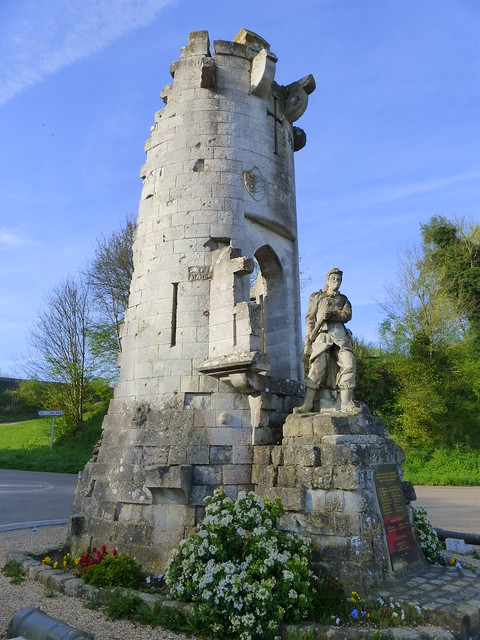 When we arrived in Moulineaux, we parked the car beside the war memorial which was constructed using the remains of an old tower from the château. The Château de Robert le Diable is a feudal castle from the time of the Dukes of Normandy.
When we arrived in Moulineaux, we parked the car beside the war memorial which was constructed using the remains of an old tower from the château. The Château de Robert le Diable is a feudal castle from the time of the Dukes of Normandy. 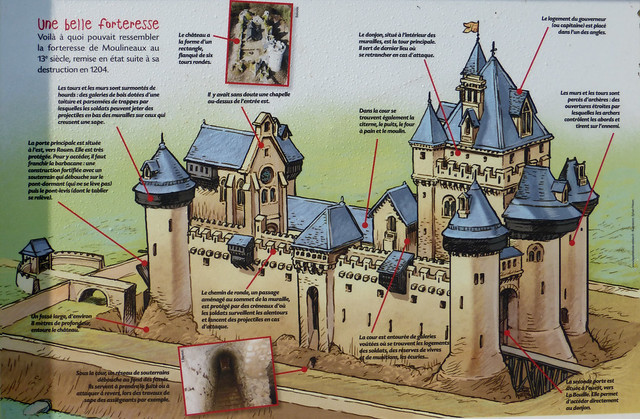
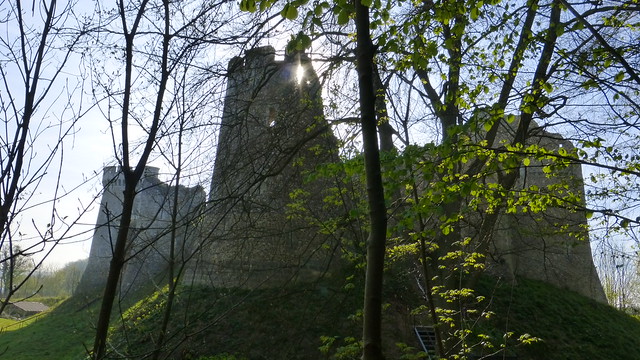
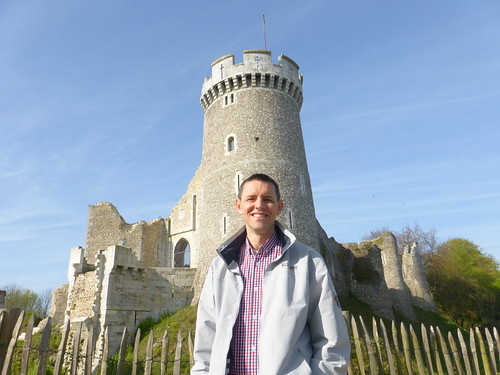 It takes its name from Robert the Devil who, according to some, was Robert de Montgommery, also known as Robert le Magnifique ('the magnificent'), Duke of Normandy and father of William the Conqueror. However, there is no evidence that this person was involved in the construction. The castle was built during the 11th and 12th centuries and stands on a hill which dominates the River Seine--the views extending over the whole Rouen region, making it a particularly strategic location.
It takes its name from Robert the Devil who, according to some, was Robert de Montgommery, also known as Robert le Magnifique ('the magnificent'), Duke of Normandy and father of William the Conqueror. However, there is no evidence that this person was involved in the construction. The castle was built during the 11th and 12th centuries and stands on a hill which dominates the River Seine--the views extending over the whole Rouen region, making it a particularly strategic location. 
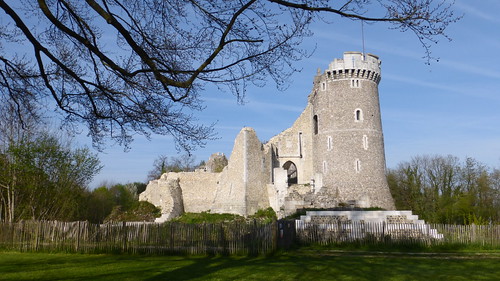
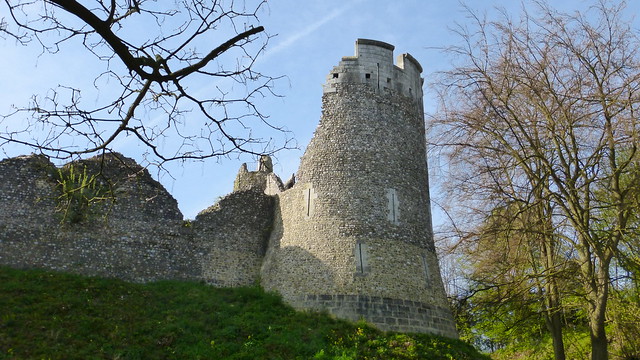
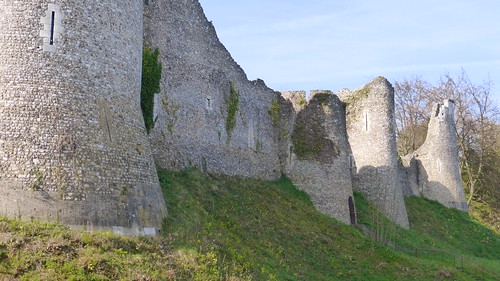
 Fortunately for us, the fog had cleared off and all that remained could be seen hovering over the Seine. It is known that the English King Richard I ('Lionheart') stayed here. His brother, King John ('Lackland') destroyed the castle during his struggle with the King of France Philip II Augustus. The latter rebuilt it. During the Hundred Years War, the people of Rouen destroyed the towers to prevent the castle being used by the English.
Fortunately for us, the fog had cleared off and all that remained could be seen hovering over the Seine. It is known that the English King Richard I ('Lionheart') stayed here. His brother, King John ('Lackland') destroyed the castle during his struggle with the King of France Philip II Augustus. The latter rebuilt it. During the Hundred Years War, the people of Rouen destroyed the towers to prevent the castle being used by the English.
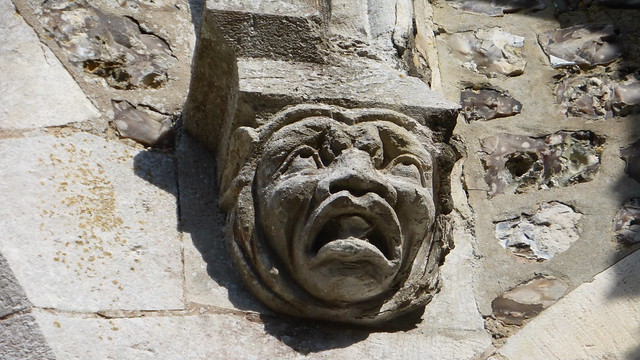
Published by The Baguette
-
in
Cultural Heritage
April 17 2014
4
17
/04
/April
/2014
09:45
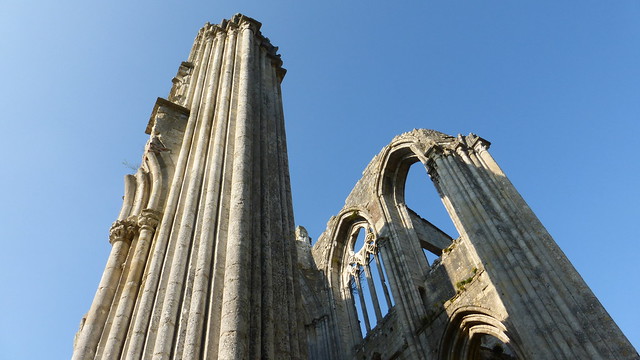
Well, it was getting rather late and after visiting Caudebec-en-Caux, we still needed to visit the Abbaye de Saint-Wandrille de Fontenelle. It is a living, working community of monks and so the buildings are not open to visitors unless you take a guided tour. Although the visitor’s center was still open, the guided tours were finished for the day. 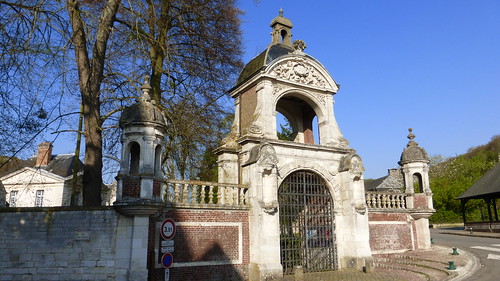 The rest of the property is open to the public and this includes some spectacular ruins that date as far back as 649 when the first community of monks moved to this area. The history of the monastery has not been at all lucky. Besides the chief basilica Saint-Wandrille built seven other churches or oratories both inside and outside the monastic enclosure.
The rest of the property is open to the public and this includes some spectacular ruins that date as far back as 649 when the first community of monks moved to this area. The history of the monastery has not been at all lucky. Besides the chief basilica Saint-Wandrille built seven other churches or oratories both inside and outside the monastic enclosure. 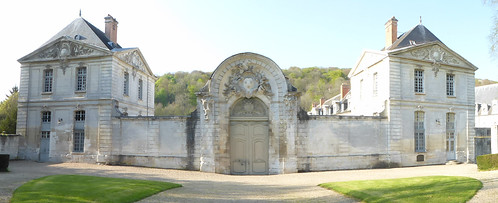 All of these have either perished in the course of time, or were replaced by others at a later date. The first church was burned down 756. In 852 it was raided by Vikings and once again burned to the ground.
All of these have either perished in the course of time, or were replaced by others at a later date. The first church was burned down 756. In 852 it was raided by Vikings and once again burned to the ground. 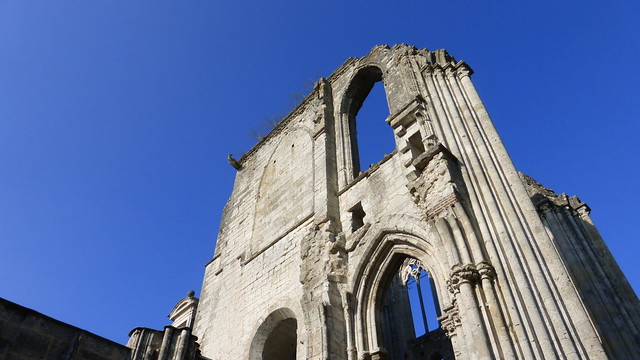 After another restoration in 966, the abbey was destroyed by lightning in 1012. After two hundred years, it burned down again in 1250.
After another restoration in 966, the abbey was destroyed by lightning in 1012. After two hundred years, it burned down again in 1250. 
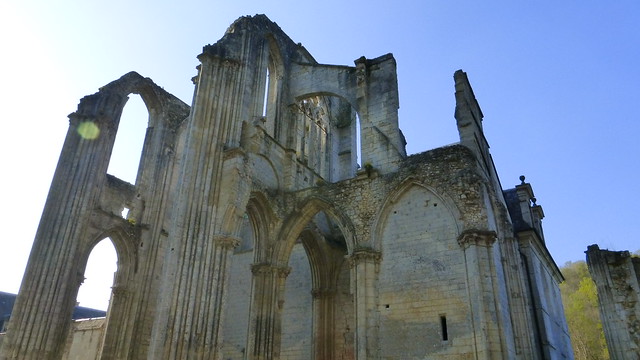 In 1631 the central tower of the church suddenly fell, ruining all the adjacent parts, but fortunately without injuring the beautiful cloisters or the conventual buildings. During the French Revolution in 1791 Fontenelle was suppressed, and in the following year the property was sold by auction. The church was partially demolished, but the rest of the buildings served for some time as a factory.
In 1631 the central tower of the church suddenly fell, ruining all the adjacent parts, but fortunately without injuring the beautiful cloisters or the conventual buildings. During the French Revolution in 1791 Fontenelle was suppressed, and in the following year the property was sold by auction. The church was partially demolished, but the rest of the buildings served for some time as a factory.  Monks came back to the area in 1898 but were expelled to Belgium in 1901. The present community of monks have been here since 1931 but once again they fell on hard times when the Germans plundered the monastery in 1940.
Monks came back to the area in 1898 but were expelled to Belgium in 1901. The present community of monks have been here since 1931 but once again they fell on hard times when the Germans plundered the monastery in 1940. 
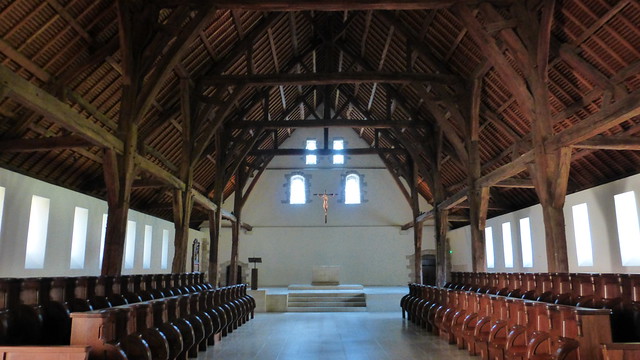 In 1969, a tithe barn from the 13th and 15th centuries from the hamlet of Canteloup à La Neuville-du-Bosc was transferred within the walls of the monastery by the monks themselves and rebuilt to become the new Abbey Church. The wood beams are bare inside and there is very little light.
In 1969, a tithe barn from the 13th and 15th centuries from the hamlet of Canteloup à La Neuville-du-Bosc was transferred within the walls of the monastery by the monks themselves and rebuilt to become the new Abbey Church. The wood beams are bare inside and there is very little light. 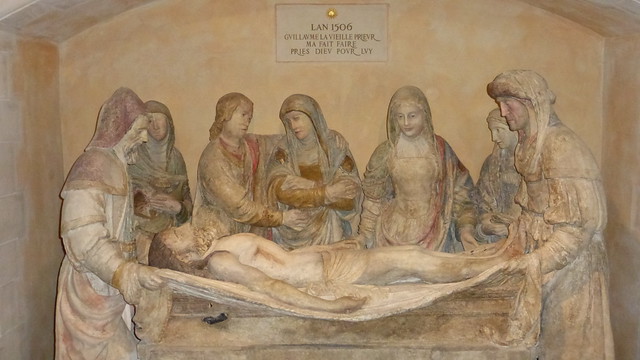 Next to the main doorway is a restored mise au tombeau from 1506.
Next to the main doorway is a restored mise au tombeau from 1506.  There is also a small, charming chapel by the monks' cemetery that is open to the public called Chapelle Notre-Dame de Caillouville-la-Neuve.
There is also a small, charming chapel by the monks' cemetery that is open to the public called Chapelle Notre-Dame de Caillouville-la-Neuve. 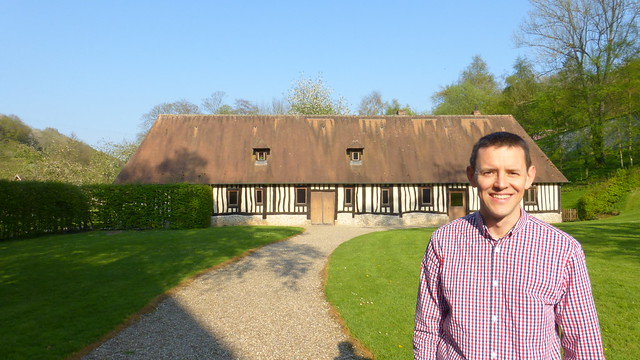
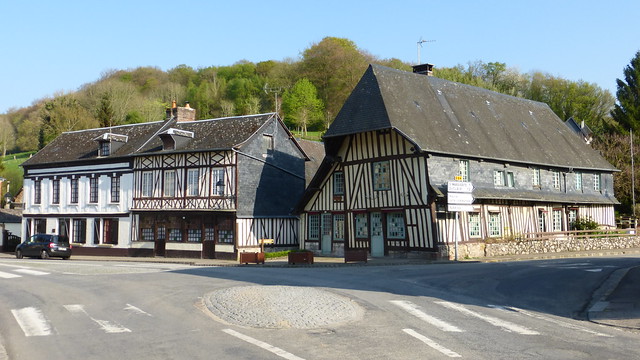 Within the town as well as the abbey property are some beautiful timber framed buildings. Just down the street is a very nice gift shop. There are products from several different monastic communities available. I purchased some beautiful Christmas cards to use next December. Near the famous abbey is the parish church which was established around 735 with materials from the Roman ruins in Lillebonne.
Within the town as well as the abbey property are some beautiful timber framed buildings. Just down the street is a very nice gift shop. There are products from several different monastic communities available. I purchased some beautiful Christmas cards to use next December. Near the famous abbey is the parish church which was established around 735 with materials from the Roman ruins in Lillebonne. 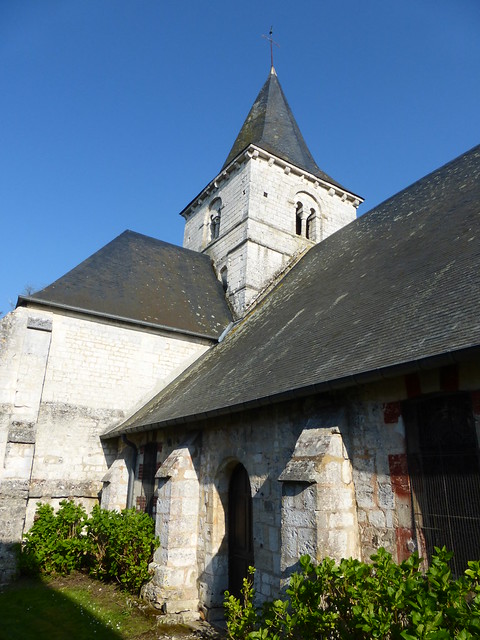
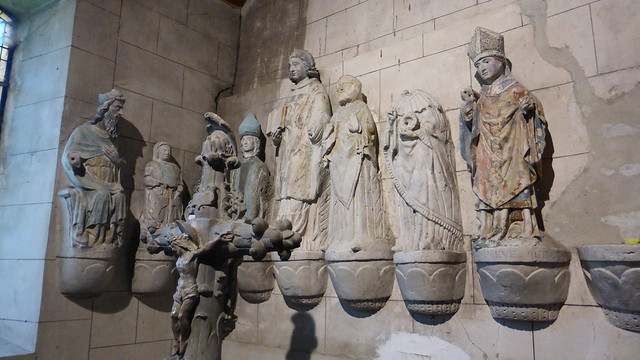 The building was destroyed during the Norman invasions, but rebuilt in wood and stone in the eleventh century. It has a rather sombre interior with walls lined with numerous statues from different centuries.
The building was destroyed during the Norman invasions, but rebuilt in wood and stone in the eleventh century. It has a rather sombre interior with walls lined with numerous statues from different centuries.
Published by The Baguette
-
in
Catholocism
April 16 2014
3
16
/04
/April
/2014
16:07
Published by The Baguette
-
in
Cultural Heritage
April 16 2014
3
16
/04
/April
/2014
13:05
Published by The Baguette
-
in
Architecture
April 16 2014
3
16
/04
/April
/2014
12:03

The weather was spectacular this last weekend that I decided to take a trip to the region around Haute Normandie known as the Seine Maritime. After making several stops to get pictures of the fields covered in rape flowers, or colza as it is known in France, I made my first stop in the delightful city near the Channel known as Fécamp. 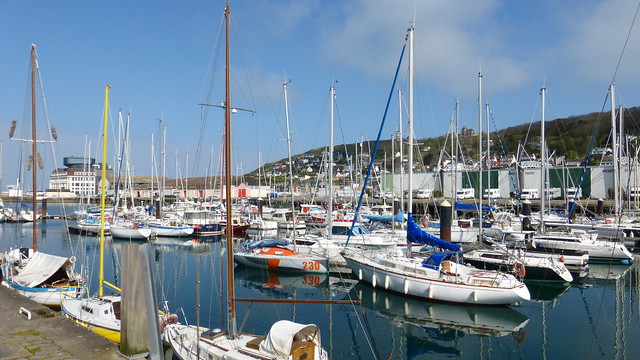 It is a fishing port as well as a center for pleasure boats. According to its late medieval founding legend, the trunk of a fig tree (ficus) carrying the Precious Blood of Christ collected by Joseph of Arimathea was washed ashore on the riverbank at Fécamp in the 1st century. Immediately, a fountain of holy blood gushed from the site; the relic attracted many medieval pilgrims, enhancing the reputation of the city.
It is a fishing port as well as a center for pleasure boats. According to its late medieval founding legend, the trunk of a fig tree (ficus) carrying the Precious Blood of Christ collected by Joseph of Arimathea was washed ashore on the riverbank at Fécamp in the 1st century. Immediately, a fountain of holy blood gushed from the site; the relic attracted many medieval pilgrims, enhancing the reputation of the city. 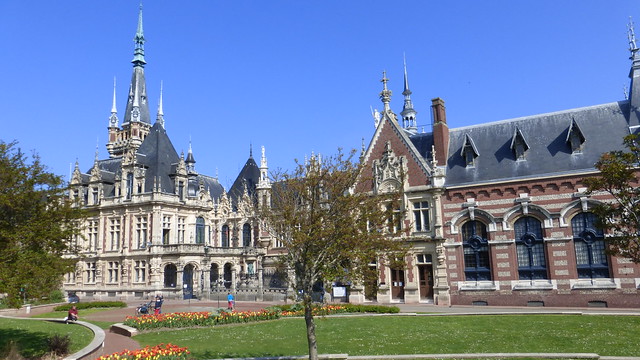
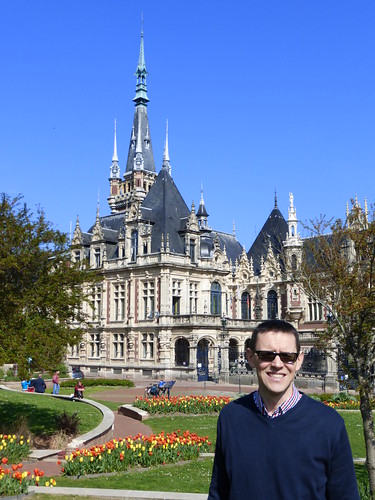 Fécamp is also known for its Palais Bénédictine where the Bénédictine liqueur is made. The building, designed by Camille Albert in the late 19th century is a mixture of neo-Gothic and neo-Renaissance styles. Inside is a museum that displays a large collection of objets d’art as well as rooms adorned in chestnut and oak.
Fécamp is also known for its Palais Bénédictine where the Bénédictine liqueur is made. The building, designed by Camille Albert in the late 19th century is a mixture of neo-Gothic and neo-Renaissance styles. Inside is a museum that displays a large collection of objets d’art as well as rooms adorned in chestnut and oak. 
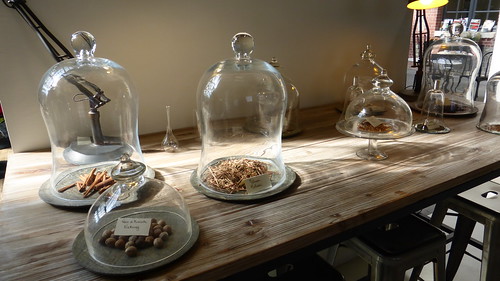
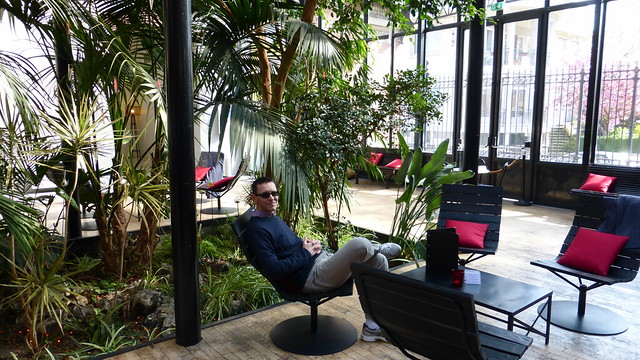 The most interesting parts of the building are the displays of objects and documents relating to the history of making Bénédictine liqueur as well as the visitor’s center with guided tours that show how the liqueur is made. After visiting the souvenir shop, we decided to take a hike along the sailors’ footpath (la sente aux matelots) to the top of the hill called Cote de la Vierge and leads to a park known as Cap Fagnet which overlooks the town.
The most interesting parts of the building are the displays of objects and documents relating to the history of making Bénédictine liqueur as well as the visitor’s center with guided tours that show how the liqueur is made. After visiting the souvenir shop, we decided to take a hike along the sailors’ footpath (la sente aux matelots) to the top of the hill called Cote de la Vierge and leads to a park known as Cap Fagnet which overlooks the town. 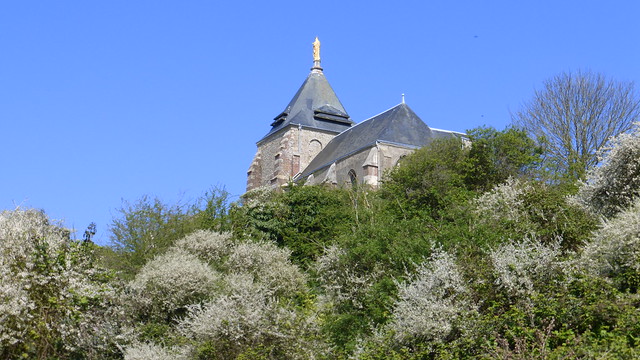
 At the end of the hike one is greeted by the Chapelle Notre-Dame-de-Salut crowned with a golden statue of the Virgin who looks out over the sea. It was originally built in the eleventh century as a chapel where pilgrims from northern France could come to honor the “Precious Blood of Christ.”
At the end of the hike one is greeted by the Chapelle Notre-Dame-de-Salut crowned with a golden statue of the Virgin who looks out over the sea. It was originally built in the eleventh century as a chapel where pilgrims from northern France could come to honor the “Precious Blood of Christ.” 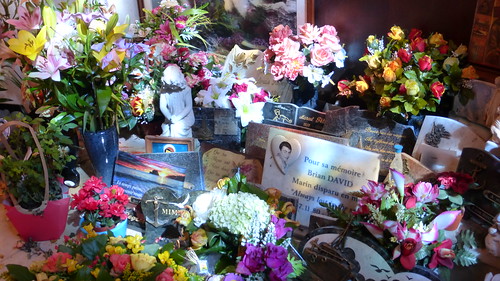 It escaped destruction during the Revolution and found another religious vocation in the nineteenth century when the fishermen of Fécamp made the chapel the goal of their pilgrimages before leaving on trips to Newfoundland via the same path I climbed known as la sente aux matelots.
It escaped destruction during the Revolution and found another religious vocation in the nineteenth century when the fishermen of Fécamp made the chapel the goal of their pilgrimages before leaving on trips to Newfoundland via the same path I climbed known as la sente aux matelots. 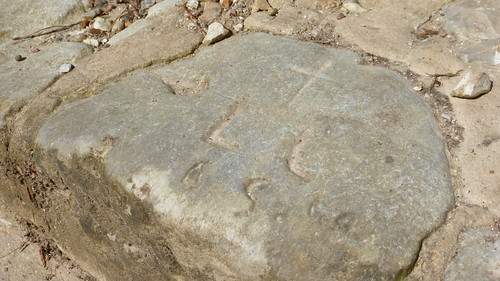 Some of the steps leading up to the chapel are adorned with religious images carved by sailors many years ago. Inside is a memorial with candles, ex-votos and flowers to all those lost at sea.
Some of the steps leading up to the chapel are adorned with religious images carved by sailors many years ago. Inside is a memorial with candles, ex-votos and flowers to all those lost at sea. 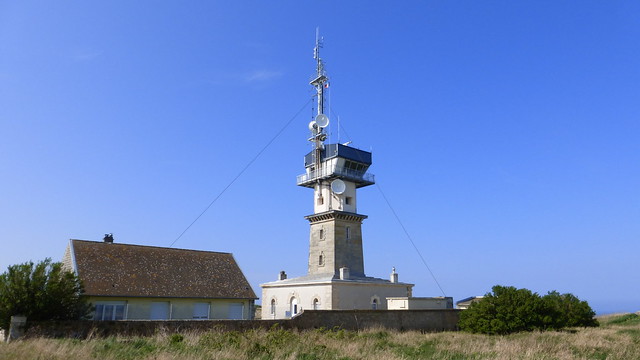 Another fixture atop the hill is the Sémaphore built in 1808 to help boats navigate to shore.
Another fixture atop the hill is the Sémaphore built in 1808 to help boats navigate to shore. 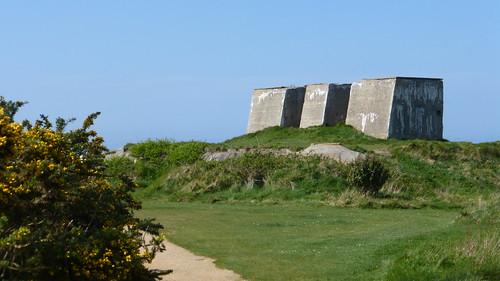
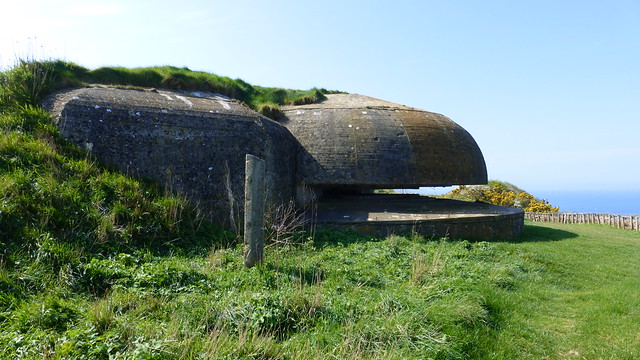
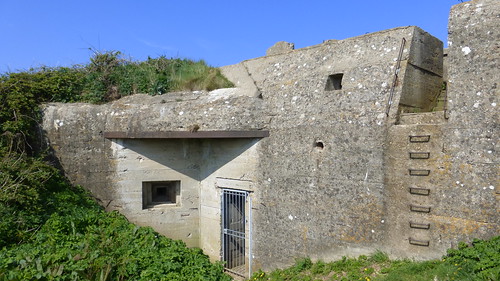 During World War II, the Germans built several large bunkers and gun turrets along the alabaster coastline which can still be seen.
During World War II, the Germans built several large bunkers and gun turrets along the alabaster coastline which can still be seen. 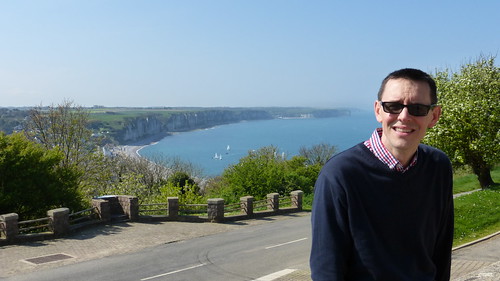
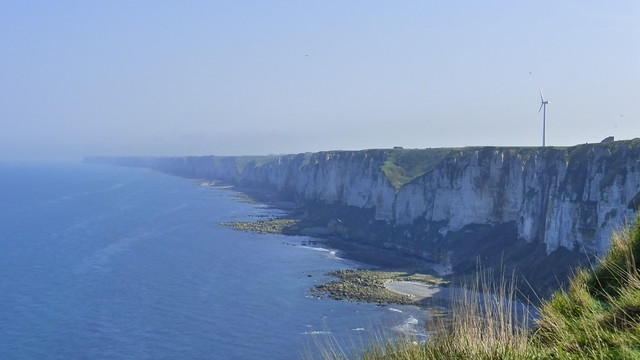 These white cliffs stretch as far as the eye can see to Étretat on one side and Dieppe on the other.
These white cliffs stretch as far as the eye can see to Étretat on one side and Dieppe on the other. 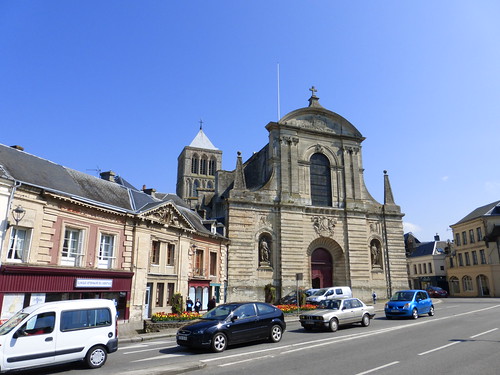
 In the city down below are many old houses as well as churches that conjure up Fécamp’s medieval history including the Abbaye de la Trinité founded in 658. The cathedral is one of the longest in France at 127 meters, equal to that of Notre-Dame in Paris. The façade of the abbey features the statues of Richard I and Richard II.
In the city down below are many old houses as well as churches that conjure up Fécamp’s medieval history including the Abbaye de la Trinité founded in 658. The cathedral is one of the longest in France at 127 meters, equal to that of Notre-Dame in Paris. The façade of the abbey features the statues of Richard I and Richard II. 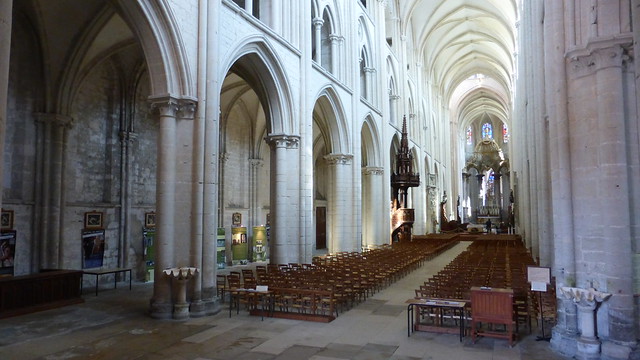
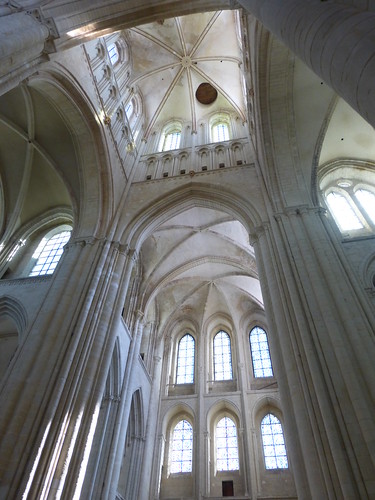 Above the transept crossing rises the square lantern tower designed in the typical Norman style.
Above the transept crossing rises the square lantern tower designed in the typical Norman style. 
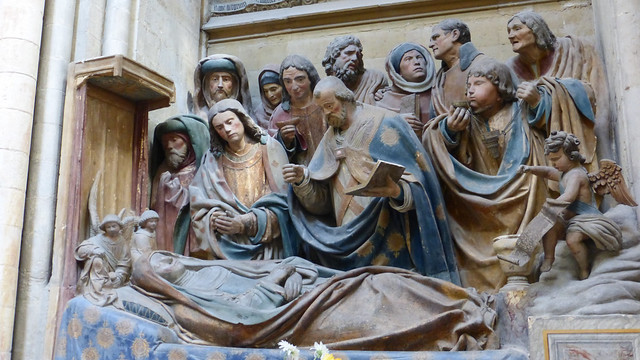
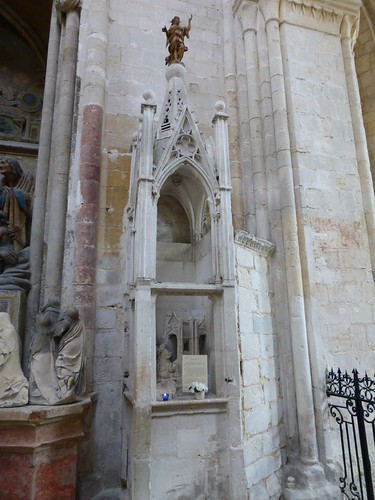 Inside the south transept is a beautiful 15th century sculpture known as the Dormition of the Virgin. To the right is the Angel’s Footprint. In 943, when the reconstructed church was being consecrated, it is said that an angel appeared and left his footprint on the stone.
Inside the south transept is a beautiful 15th century sculpture known as the Dormition of the Virgin. To the right is the Angel’s Footprint. In 943, when the reconstructed church was being consecrated, it is said that an angel appeared and left his footprint on the stone. 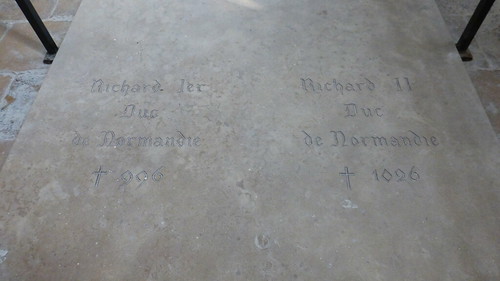
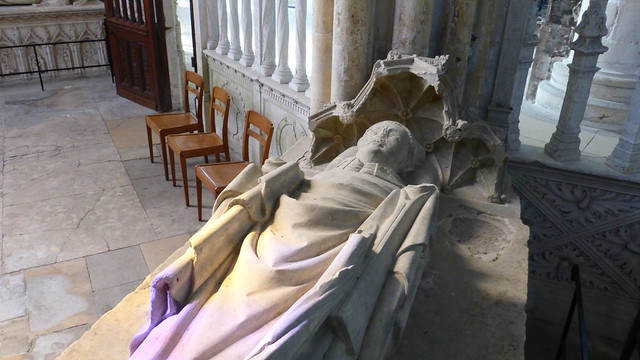 There are several recumbent effigies and tombs within the church as well including those of the two benefactors of the abbey, Richard I (943 – 996), grandson of Rollon, a Viking chief and beside him, his son Richard II (996 – 1026).
There are several recumbent effigies and tombs within the church as well including those of the two benefactors of the abbey, Richard I (943 – 996), grandson of Rollon, a Viking chief and beside him, his son Richard II (996 – 1026). 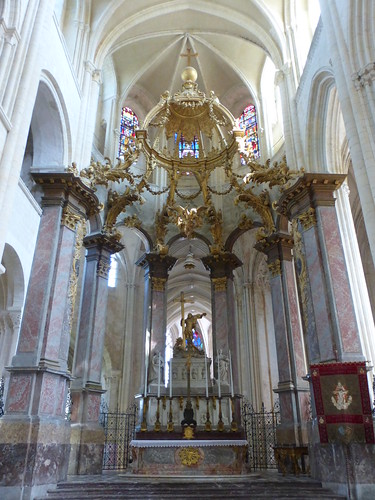 The high altar was rebuilt in the mid-eighteenth century with a lavish canopy of gilded wood and pillars of red marble.
The high altar was rebuilt in the mid-eighteenth century with a lavish canopy of gilded wood and pillars of red marble. 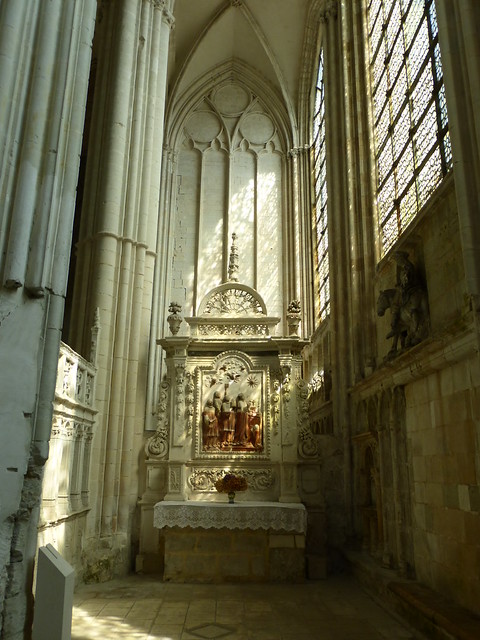

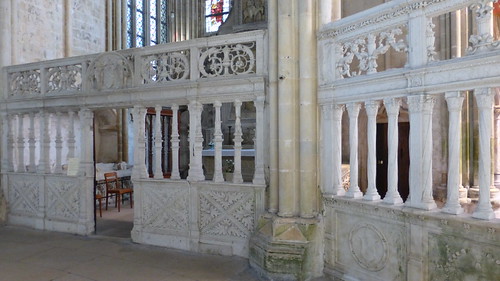 The side chapels around the church are all enclosed with stone walls which are intricately decorated and altars that are ornately carved. One interesting feature of the church is the astronomical and tidal clock which dates from 1667 and is still in good working order.
The side chapels around the church are all enclosed with stone walls which are intricately decorated and altars that are ornately carved. One interesting feature of the church is the astronomical and tidal clock which dates from 1667 and is still in good working order.  It is one of the first clocks of its kind to display two needles to indicate the hours and minutes as well as the phases of the moon and tidal forces of Fécamp.
It is one of the first clocks of its kind to display two needles to indicate the hours and minutes as well as the phases of the moon and tidal forces of Fécamp.  Behind the high altar facing the chapel to Our Lady is the tabernacle containing the relic of the Precious Blood of Jesus.
Behind the high altar facing the chapel to Our Lady is the tabernacle containing the relic of the Precious Blood of Jesus. 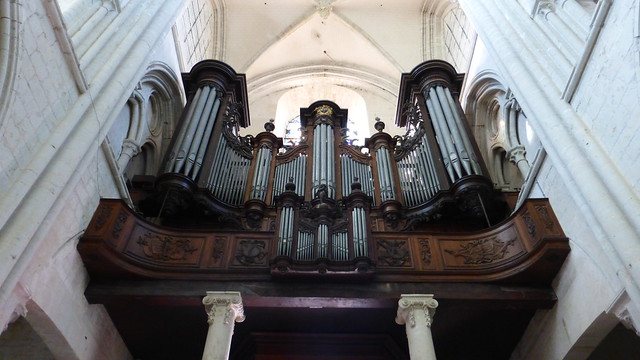 The fine organ above the western portal was installed in 1746.
The fine organ above the western portal was installed in 1746.  Across from the abbey is the home of the monks from the seventeenth century, known as Maison des Moines insoumis.
Across from the abbey is the home of the monks from the seventeenth century, known as Maison des Moines insoumis. 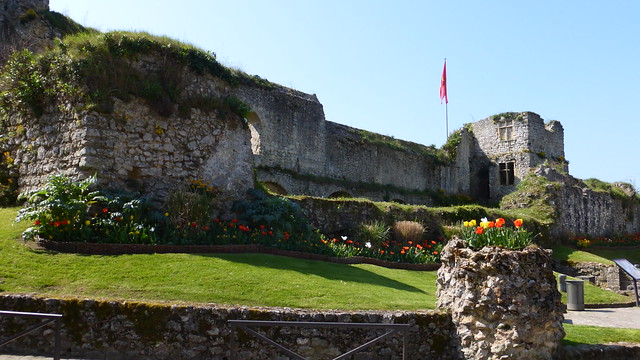 Another interesting residence is the Ducal Palace which was originally built in the 10th century on the site of an ancient nunnery destroyed by the Vikings. At the end of the 12 century, Henri II Plantagenet, the husband of Eleanor of Aquitaine, came to Fécamp to assert his rights over Normandy. He built the enormous fortified bastion on top of the ancient ramparts which can still be seen today. It was eventually dismantled and the castle was integrated into the monastic property around the abbey.
Another interesting residence is the Ducal Palace which was originally built in the 10th century on the site of an ancient nunnery destroyed by the Vikings. At the end of the 12 century, Henri II Plantagenet, the husband of Eleanor of Aquitaine, came to Fécamp to assert his rights over Normandy. He built the enormous fortified bastion on top of the ancient ramparts which can still be seen today. It was eventually dismantled and the castle was integrated into the monastic property around the abbey.  This is a long section of wall known as the Dukes’ Wall which is a vestige of the defensive wall of the palace and the Abbey erected in the 11th century.
This is a long section of wall known as the Dukes’ Wall which is a vestige of the defensive wall of the palace and the Abbey erected in the 11th century. 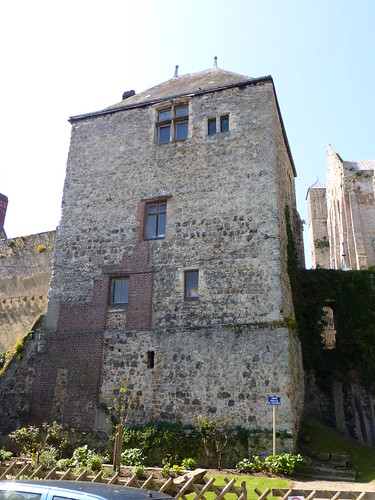 This is La tour de la Maîtrise or Choir School Tower. It is part of the ancient exterior fortifications whose defences were composed of alternating round and square towers. It rises to two floors and in the Middle Ages it housed the famous Fécamp music school that provided the abbey with instrumental and vocal music. It is said that the choir’s repertoire was so extensive that it could be sung for ten years without ever repeating the same piece twice.
This is La tour de la Maîtrise or Choir School Tower. It is part of the ancient exterior fortifications whose defences were composed of alternating round and square towers. It rises to two floors and in the Middle Ages it housed the famous Fécamp music school that provided the abbey with instrumental and vocal music. It is said that the choir’s repertoire was so extensive that it could be sung for ten years without ever repeating the same piece twice. 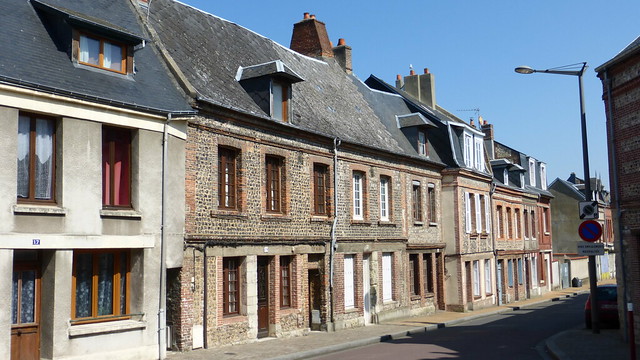 A walk through the old town takes you past many old houses which were originally workshops and homes of artisans and shopkeepers attracted to this area by the continual flow of pilgrims who visited the abbey.
A walk through the old town takes you past many old houses which were originally workshops and homes of artisans and shopkeepers attracted to this area by the continual flow of pilgrims who visited the abbey.  Nearby is the old hospital with a chapel built over a stream. Another very small building in the area is known as the Chapelle du Précieux-Sang and although it is not recognized by the local Catholic Community, in the garden adjoining the chapel is a spring whose waters are supposed to cure eczema.
Nearby is the old hospital with a chapel built over a stream. Another very small building in the area is known as the Chapelle du Précieux-Sang and although it is not recognized by the local Catholic Community, in the garden adjoining the chapel is a spring whose waters are supposed to cure eczema.  According to some 19th century documents, owners of this garden charged patients for a few ounces of the holy water. One of the nicest surprises that Fécamp had to offer was le petit parc, a small green oasis located amidst all the buildings in the newer part of town.
According to some 19th century documents, owners of this garden charged patients for a few ounces of the holy water. One of the nicest surprises that Fécamp had to offer was le petit parc, a small green oasis located amidst all the buildings in the newer part of town. 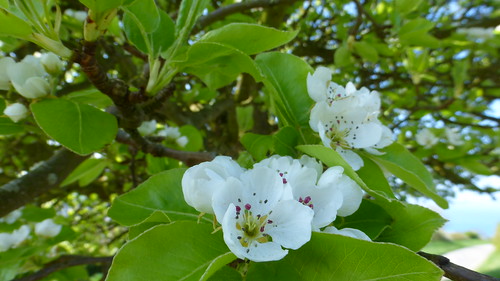

 Inside, is the memorial to fisherman lost at sea erected for the “Thousand Years of Normandy” celebrations in 1911. It draws inspiration from the figure heads of Viking ships.
Inside, is the memorial to fisherman lost at sea erected for the “Thousand Years of Normandy” celebrations in 1911. It draws inspiration from the figure heads of Viking ships. 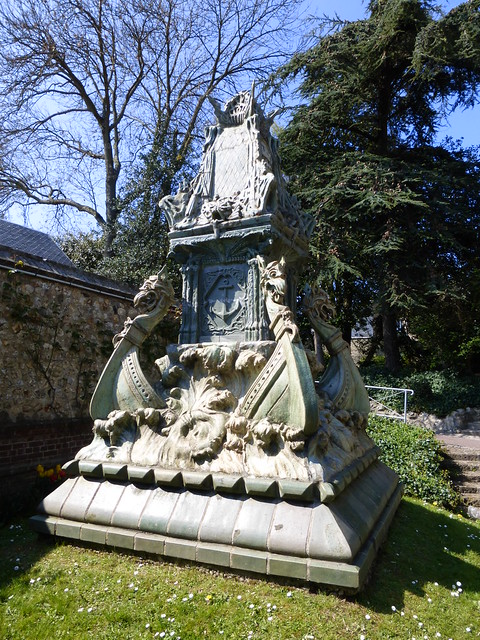
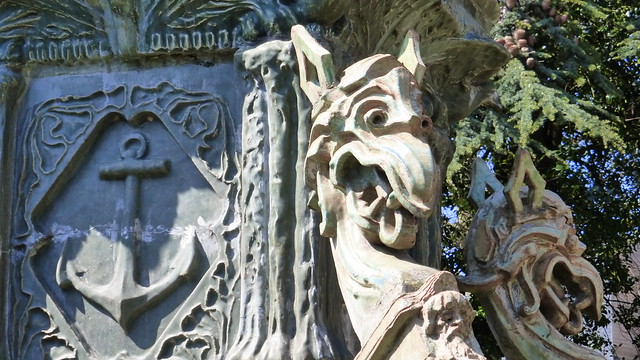 In all, Fécamp was a great place to spend the morning.
In all, Fécamp was a great place to spend the morning.
Published by The Baguette
-
in
Cultural Heritage
April 15 2014
2
15
/04
/April
/2014
07:56
Published by The Baguette
-
in
Cotentin
April 10 2014
4
10
/04
/April
/2014
13:08
Published by The Baguette
-
in
Cotentin
April 10 2014
4
10
/04
/April
/2014
12:38
Published by The Baguette
-
in
Basse-Normandie
April 10 2014
4
10
/04
/April
/2014
09:27
Published by The Baguette
-
in
Catholocism
April 10 2014
4
10
/04
/April
/2014
08:09
Published by The Baguette
-
in
Architecture
 On the morning of my second day, I had a sumptuous breakfast in the dining room of our chambre d’hote. The owner was very kind and served us fresh crepes with several different homemade jams and conserves. While I ate, I wondered what the day was going to bring since the countryside appeared to be covered in a thick fog.
On the morning of my second day, I had a sumptuous breakfast in the dining room of our chambre d’hote. The owner was very kind and served us fresh crepes with several different homemade jams and conserves. While I ate, I wondered what the day was going to bring since the countryside appeared to be covered in a thick fog. 

 I took a few photos of Au Temps de Cerises and then decided that the fog would likely burn off by the time I reached my first destination for the day, the Château de Robert le Diable.
I took a few photos of Au Temps de Cerises and then decided that the fog would likely burn off by the time I reached my first destination for the day, the Château de Robert le Diable.  Since there was no bridge over the Seine nearby, we would have had to take the road around the river and put over 50km on our car. Fortunately, drivers can take the ferry over the river at Le Mesnil-sous-Jumièges and the distance is only 18km.
Since there was no bridge over the Seine nearby, we would have had to take the road around the river and put over 50km on our car. Fortunately, drivers can take the ferry over the river at Le Mesnil-sous-Jumièges and the distance is only 18km.  The ferry had to wait for eight vehicles to board before casting off to the other side of the Seine which we couldn’t even see because of all the fog.
The ferry had to wait for eight vehicles to board before casting off to the other side of the Seine which we couldn’t even see because of all the fog.  When we arrived in Moulineaux, we parked the car beside the war memorial which was constructed using the remains of an old tower from the château. The Château de Robert le Diable is a feudal castle from the time of the Dukes of Normandy.
When we arrived in Moulineaux, we parked the car beside the war memorial which was constructed using the remains of an old tower from the château. The Château de Robert le Diable is a feudal castle from the time of the Dukes of Normandy. 

 It takes its name from Robert the Devil who, according to some, was Robert de Montgommery, also known as Robert le Magnifique ('the magnificent'), Duke of Normandy and father of William the Conqueror. However, there is no evidence that this person was involved in the construction. The castle was built during the 11th and 12th centuries and stands on a hill which dominates the River Seine--the views extending over the whole Rouen region, making it a particularly strategic location.
It takes its name from Robert the Devil who, according to some, was Robert de Montgommery, also known as Robert le Magnifique ('the magnificent'), Duke of Normandy and father of William the Conqueror. However, there is no evidence that this person was involved in the construction. The castle was built during the 11th and 12th centuries and stands on a hill which dominates the River Seine--the views extending over the whole Rouen region, making it a particularly strategic location. 



 Fortunately for us, the fog had cleared off and all that remained could be seen hovering over the Seine. It is known that the English King Richard I ('Lionheart') stayed here. His brother, King John ('Lackland') destroyed the castle during his struggle with the King of France Philip II Augustus. The latter rebuilt it. During the Hundred Years War, the people of Rouen destroyed the towers to prevent the castle being used by the English.
Fortunately for us, the fog had cleared off and all that remained could be seen hovering over the Seine. It is known that the English King Richard I ('Lionheart') stayed here. His brother, King John ('Lackland') destroyed the castle during his struggle with the King of France Philip II Augustus. The latter rebuilt it. During the Hundred Years War, the people of Rouen destroyed the towers to prevent the castle being used by the English. 





















